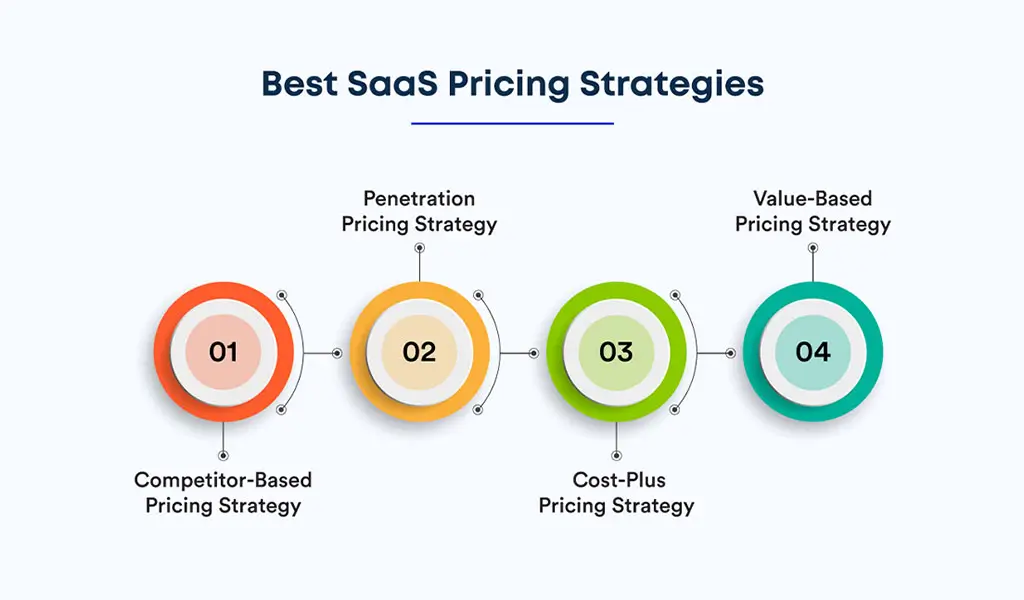Software as a Service (SaaS) pricing plans must be understood very closely to meet user-expectations and market trends. In fact, the SaaS industry getting hotter and competitive every day as we inch closer to 2023, thus, it is imperative for companies to adopt pricing strategies that meet diverse demands of their customers and also justify the value of their products effectively.
In this blog, we are talking about the best SaaS pricing strategies which are the part of success stories in 2023. Value-based pricing, freemium are the ideal examples of those strategies which you have to implement to grab the market share and build long-term association with customers. So, let us guide you to develop an ever-effective SaaS pricing strategy for your enterprise.

Pricing strategy for SaaS
1. Freemiums & Free Trials
It’s a mix of two words “free” and “premium”. Here, the consumer is allowed to have the free basic version of the program, but there is an option to subscribe to the upgraded version. This strategy is likely to attract many consumers because it’s free, and at the same time, it provides the option to upgrade to premium. Upselling to premium customers is also likely to increase because customers would willingly pay if they perceive the expanded offering to be of value to them. Free TrialsFree trials provide users a temporary option to use all the features for free, but only for a limited time.
This strategy allows the users to evaluate the product’s functionality before they actually subscribe to it. Freemium and free trials are considered to be good entry points because they attract potential customers and provide them with practical experiences that often lead to increased conversion rates and long-term users. So yes! Freemium and Free trial pricing strategy for SaaS is good
2. Tiered Pricing
One of the absolute biggest uses of this method is offering different subscription options to consumers by needs and financial restrictions — it will often be with tiered-pricing anyway. Across its various tiers, features and services have been divided, fitting the elements within different price ranges and ranges of helpfulness, as the theory go.
Customers are allowed to choose from the available SaaS consumption tier appropriately. Therefore, it is scalable and flexible.In addition to catering to the needs of diverse clientele, tiered pricing helps enterprises in optimizing the revenue by accommodating both the beginner users and advanced users looking for complex features. The graduated pricing model is a versatile and widely recognized pricing method in the very competitive SaaS market. It enables upselling, and allows the customers to effortlessly re-size their members Pricing Strategy hip and so forth. as their desires change.
3. Usage-Based Pricing
This is a very flexible and forward-thinking SaaS pricing model, and one of the more economical uses of usage-based pricing. It means charging according to consumption. In this type of pricing model, customers are charged based on the features or resources they consume. It allows consumers to optimize and scale costs. Since they may optimize costs based on patterns of consumption, businesses with fluctuating loads will find this approach very attractive. Usage-based pricing motivates efficient software consumption by offering customers transparency and incentives. Because they can accommodate a broad array of user situations, they are becoming familiar in the SaaS industry and today represent a smart strategic choice for enterprises seeking to balance cost-efficiency and value creation.
4. Time Limited Pricing
Time-limited pricing lends the SaaS pricing a temporal feel and creates a very alluring time-constrained method. Using this tool, businesses create exclusive offers or discounts available for only a short span of time, in order to drive potential customers to act fast and convert before the opportunity is gone.
A must-have pricing strategy for seasonal advertising, product launches and sales. Fast convinction & enhances customer acquisition rate Time-limited pricing leverages the scarcity principle and triggers our feelings of urgency, incentivizing purchases by motivating customers into acting on a special offer or lower price that will expire when the clock runs out. This price model creates a sense of excitement and urgency in the fast-paced SaaS industry, which helps to shorten sales cycles and enhance customer engagement.
5. Hybrid Pricing
In the SaaS market, businesses are now going one step ahead to try out a mix of SaaS pricing models. It is quite an effective SaaS pricing strategy. It not only helps in catering to more customers with varying affordabilities but also diversifies the revenue stream. Companies that want to get customers from every walk of life opt for the hybrid billing model. Also, it allows users to make changes in pricing plans and models when it is needed which shows the flexibility of this pricing model.
Hopefully, the idea of different pricing strategies for SaaS is clear to you. There are many other pricing plans, models and strategies that SaaS companies use, but these can help thrive better this year.
In conclusion
As the SaaS industry progresses, this pricing strategy offers businesses the flexibility and development needed to thrive in a competitive landscape. By selecting and familiarizing these strategies to their unique environments, businesses can advance revenue streams, advance customer satisfaction, and stay ahead of the dynamic SaaS market in 2023.





